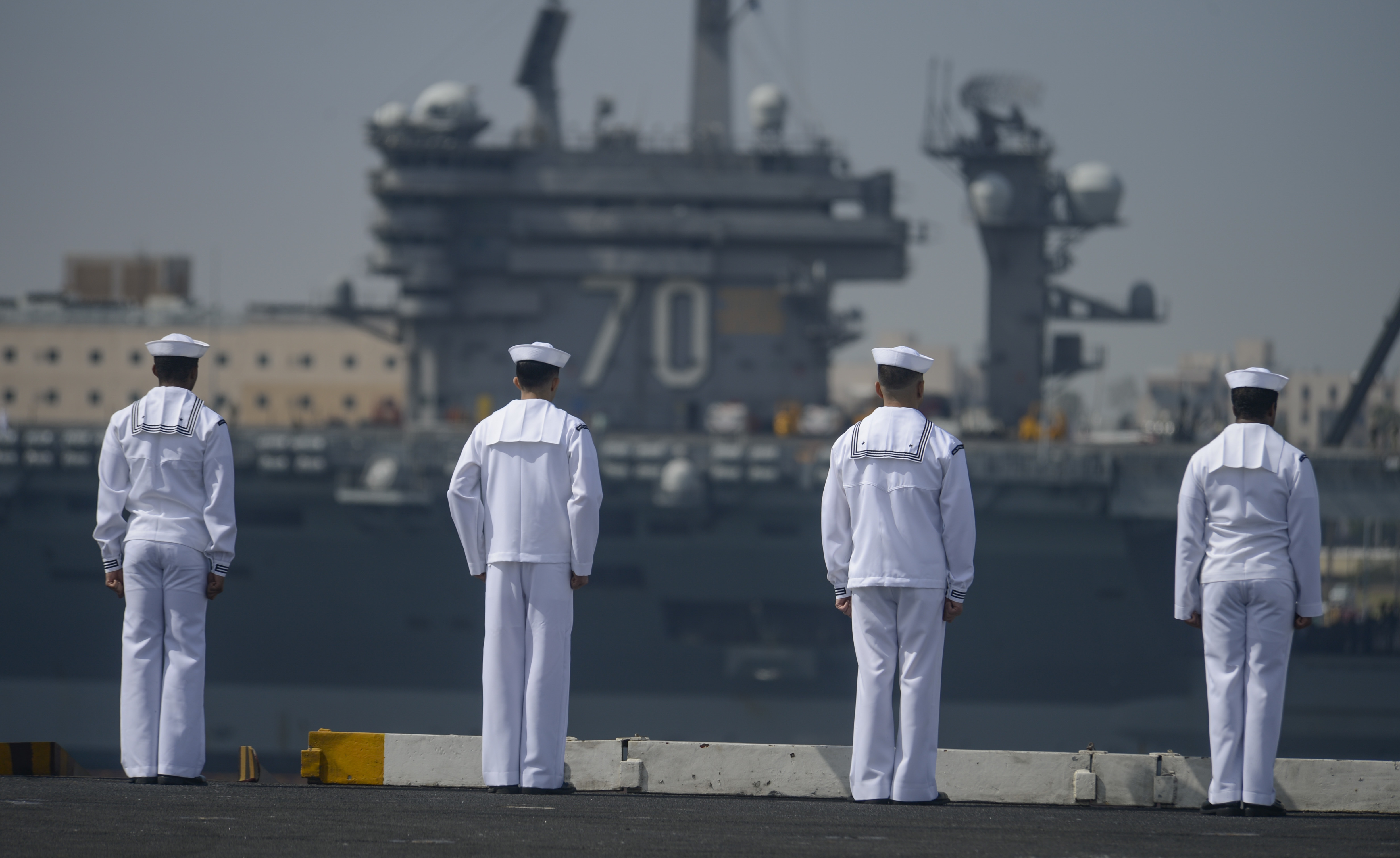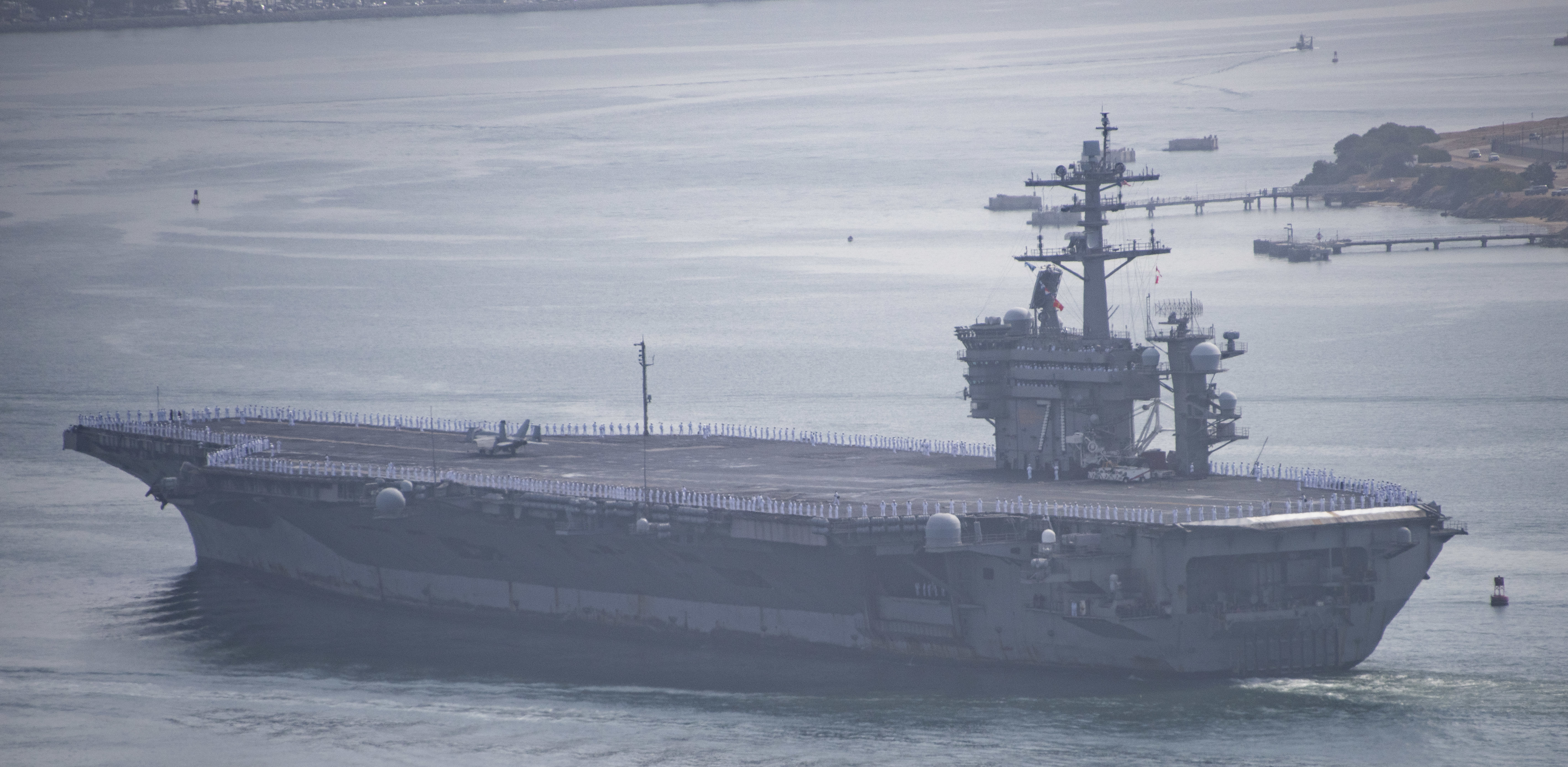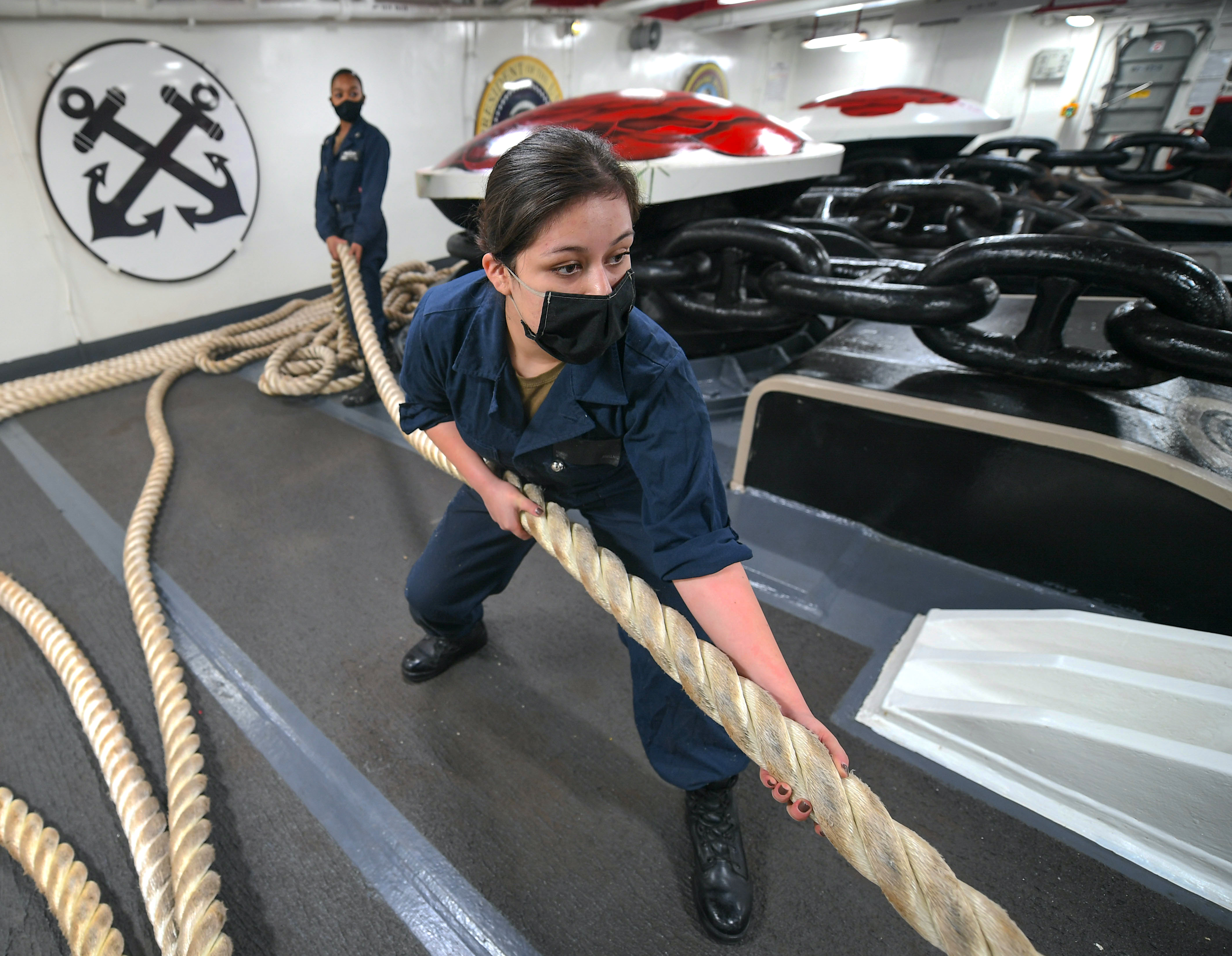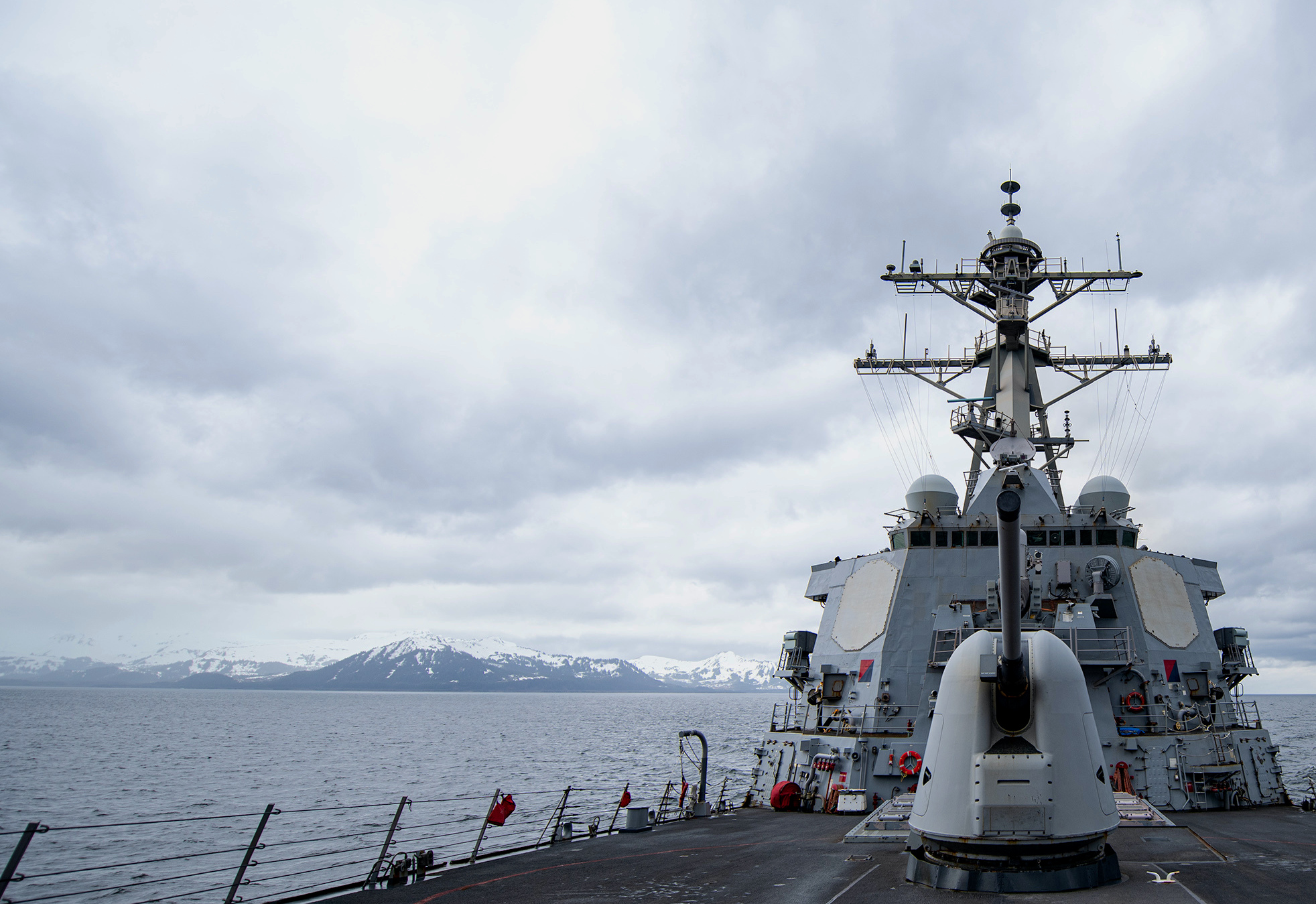
Aircraft carrier USS Theodore Roosevelt(CVN-71) pulled into its berth at Naval Air Station North Island, Calif., on Tuesday morning, completing its second overseas deployment in 16 months.
The carrier, flagship for the Roosevelt Carrier Strike Group, had left San Diego in October 2020 for a final set of pre-deployment training exercises before officially beginning deployment operations in the U.S. 7th Fleet and 3rd Fleet regions. The strike group included Carrier Air Wing 11, Destroyer Squadron 23, Ticonderoga-class guided-missile cruiser USS Bunker Hill (CG-52) and Arleigh Burke-class guided-missile destroyer USS Russell (DDG-59).
In returning home, the strike group fully completed its scheduled overseas deployment, a different outcome from its early 2020 deployment that was cut short by a COVID-19 outbreak aboard the carrier.
“When we were coming home from the last deployment, I had to tell the crew that they’re coming back to a very different America than they left, because while we were gone, COVID had struck,” Rear Adm. Doug Verissimo, the Carrier Strike Group 9 commander, told USNI News by phone as Roosevelt it made its way into San Diego Bay Tuesday morning. “We were coming back to our home country, where we were requiring masks and we didn’t really have that freedom of movement to do the things that sailors like to do when you get back from a seven-month deployment.”
But this time, Verissimo said, he got to tell them that “we’re coming back to America that is different than the one we left. Things are opening back up, not completely, but our sailors are really excited.”
After so many months of isolation – for some, lasting more than a year – strike group personnel are reuniting with their families and friends in less-restrictive environments. Some sailors already are vaccinated for COVID-19, having received the one-dose Johnson & Johnson vaccine offered a month ago, Verissimo said. Other sailors have been asking for the Pfizer or Moderna COVID-19 vaccines as well, “and we’ve got a ‘shot-ex’ coming up” this week ahead of the Memorial Day weekend.
“So we’re going to have a very protected crew, and I fully expect our lives to slowly transition to what used to be normal. Our sailors are very excited to experience that again,” he added.
Important Presence

For its 2020-2021 deployment, the Roosevelt CSG operated throughout the Pacific and Indian oceans, “all the way west to nearly in the 5th Fleet area of responsibility,” Verissimo said. Earlier this month, the strike group operated in Alaskan waters joining in the multi-service exercise Northern Edge 2021, run by U.S. Indo-Pacific Command, before heading home.
Aboard Roosevelt were the “Tomcatters” of Strike Fighter Squadrons 31, “Golden Warriors” of VFA-87, “Blue Diamonds” of VFA-146, “Black Knights” of VFA-154, “Liberty Bells” of Airborne Command and Control Squadron 115, “The Gray Wolves” of Electronic Attack Squadron 142, “Wolf Pack” of Helicopter Maritime Strike Squadron 75, “Eightballers” of Helicopter Sea Combat Squadron (HSC) 8 and “Providers” of Fleet Logistic Support Squadron 30 Detachment 3.
While it planned for the possibility, Roosevelt didn’t spend time in the Persian Gulf region, a mission and presence that’s mostly been routine for aircraft carrier deployments and its embarked squadrons in recent decades to support U.S. Central Command operations. Still, while operating in the U.S. 7th Fleet region, Verissimo noted, “ we were really well-versed and ready to go in either direction,” he said. “It’s not a very long drive to get anywhere else in the world, to include the Mediterranean. So we were keeping our eye on the news and the geopolitical environment throughout.”
That includes key hot spots like the South China Sea, where China’s expanding influence, large maritime and naval fleet, and contested land claims continue to rattle regional countries. Roosevelt twice operated in the South China Sea – including with the Makin Island Expeditionary Strike Group – while sailing through international waters that still drew strong complaints from Chinese officials.
“A carrier strike group, in general, gives our decision-makers time and space to negotiate,” Verissimo said. A carrier’s deployment “sends a message that we want to make sure that things don’t change rapidly.”
In the South China Sea, he said, that means ensuring “ the freedom to operate and for our friendly nations and for all nations to have unfettered access to international waters, and we don’t start redrawing lines and that those norms and traditions stay consistent.”
“We operate in international waters when and where and at our time of choosing, and we want to keep it that way for all nations,” he added.
COVID-19 Fight Before Deploying

Verissimo, a career aviator, took command of the strike group June 9, 2020, as Roosevelt operated in the Philippine Sea. It was a month after the carrier had returned to sea after it was stuck in Guam due to the outbreak of the SARS-CoV-2 virus among crew members in early March 2020, just two months after departing San Diego for its scheduled deployment to the Indo-Pacific. Medical researchers began initial testing while the Navy, and the rest of the U.S. and world, implemented strict measures and travel restrictions to stem the spread of the virus that causes COVID-19.
Lessons from that earlier experience battling the virus, which ultimately infected 1,200 Roosevelt crew members, helped shape the Navy’s approach to fight the coronavirus and help prevent new outbreaks as Roosevelt and the rest of the strike group again came together to train for the new deployment.
“We really learned how to mitigate that risk,” Verissimo said. Initially, “there was some confusion on what we really needed to do. But as a team on the deckplate, the sailors were tight, they worked together. There was no doubt that the shipmate to the left and to the right didn’t have each other’s backs. So I was pretty confident in the team.”
“Being the first to have an outbreak, we learned and were very smart on how to deal with it,” Verissimo said, noting the unique challenges of dealing with virus spread in the tight, closed environment of a ship at sea.
Roosevelt crews began their pre-deployment quarantine on Nov. 16. “Some” of the 5,400 personnel aboard the carrier tested positive for COVID, he said, “and we made sure that didn’t spread and we’d have additional cases as we came together. We did that successfully, and that’s no small task. That was a major mission accomplishment right off the bat. So that installed a little bit of confidence in fighting the virus.”
After a “quick trip to Guam, we took on nearly 250 additional personnel,” he said. “In our close-contact testing, we had three total, three asymptomatic cases.”
With those findings, “of course, the crew became very aware” of how it could spread,” he added. “We all took action, and we stopped it on its track.” Extensive, follow-up testing, he added, found “we didn’t have any additional cases.”
In the end, “we were able to do our mission,” Verissimo said. “We weren’t just fighting the virus we were … doing everything we were scheduled for, and a lot more.”
Partnerships At Sea

While deployed, the Roosevelt CSG operated at one point with USS Nimitz (CVN-68) and trained and worked with military counterparts from Australia, India, Malaysia and Japan. “Although we couldn’t do port calls in foreign ports [due to COVID-19 restrictions], we were able to work with those folks underway and continue that relationship,” Verissimo said.
An unplanned interoperability opportunity arose while Roosevelt was in Guam and the Japan Maritime Self-Defense Force’s ships were training in the region, he said. Joining Roosevelt in the bilateral maritime exercise in mid-January were Bunker Hill, guided-missile destroyer USS John Finn (DDG-113), and JMSDF destroyers JS Kongo (DDG-173) and JS Asahi (DD-119).
The strike group’s Russell deployed to Oceania, where many South Pacific island-nations’ claims to fisheries and other natural resources have been under threat, and helped “enforce a rules-based international order and support a free and open Indo-Pacific,” according to a 3rd Fleet news release. The ship’s crew helped enforce Economic Exclusion Zone (EEZ) operations, ran patrols with the Federated States of Micronesia’s Maritime Law Enforcement units and worked with the Republic of the Marshall Islands and Papua New Guinea. “The work they did as part of the Theodore Roosevelt Strike Group helped to promote a free and open Indo-Pacific and ensured security and prosperity in the region,” Capt. Steven McDowell, Destroyer Squadron 23’s commander, said in a statement.
Before returning home this spring, the Roosevelt CSG was among the 15,000 U.S. service members who participated in Northern Edge in an around Alaska. The exercise provided a different kind of training challenge as sailors donned coats and hats and ships had to turn off air-conditioners and use heaters, a rare requirement for the typical Indo-Pacific deployments at sea.
“Continuing to keep those systems and our sailors’ appreciation and understanding of how to operate in those environments is key,” Verissimo said. “It was a great opportunity to get up in the Alaskan gulf with a maritime force and interface with the Marine Corps. Between blue water and the littoral water, and then engaging with our Air Force and Army counterparts to work further inland, it was a great joint exercise.”





